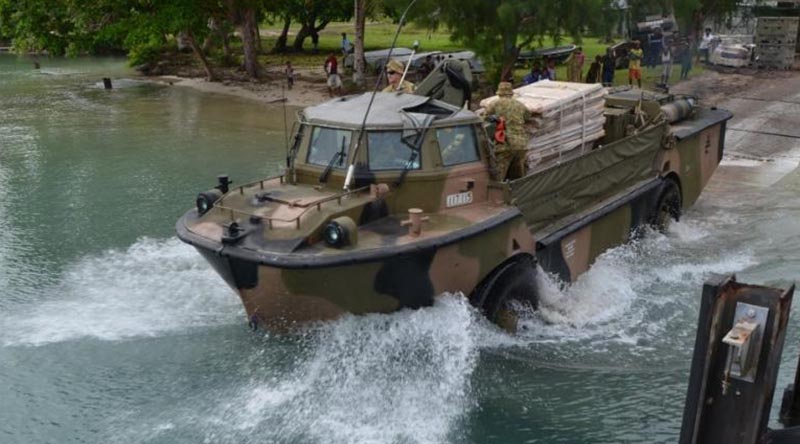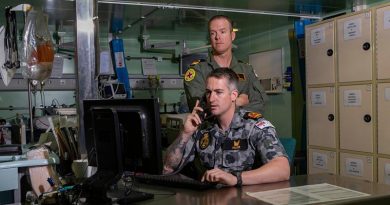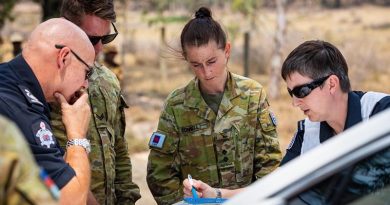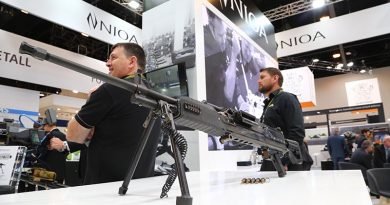$800million for new Australian-made landing craft and amphibs
Share the post "$800million for new Australian-made landing craft and amphibs"

Defence will invest up to $800million to acquire new fleets of Australian-built amphibious vehicles and landing craft that will be able to transport land forces with enhanced speed and protection.
FILE PHOTO (February 2013): Papua New Guinean children watch a lighter amphibious resupply cargo – vehicle (LARC-V) retrieve ADF equipment from Manus Island, used to build temporary offshore immigration processing facilities. Royal Australian Navy photo.
Through this project, an independent landing craft will be delivered to replace the Army’s existing LCM-8 vessels and an amphibious vehicle will also be built to replace Army’s current LARC-V.
With two separate fleets to be acquired, the watercraft will provide independent shore-to-shore, ship-to-shore, and over-the-shore capabilities to better manoeuvre and sustain the ADF in littoral and riverine environments.
Minister for Defence Linda Reynolds said the Army Littoral Manoeuvre – Light project, LAND 8710 Phase 1 would strengthen the ADF’s amphibious capabilities.
“These new vessels, introduced from 2026, will be larger, faster and better protected to support ADF operations,” Minister Reynolds said.
“They will allow Defence to quickly and effectively deploy both domestically and to our near region, as well as remain engaged with regional security partners and support humanitarian assistance to our neighbours in the Indo-Pacific.
“We have also seen the importance of the Army water transport capability most recently on Operation Bushfire Assist 19-20, evacuating Australians to safety off beaches and delivering much needed supplies.”
Minister for Defence Industry Melissa Price said the investment in these fleets demonstrated a commitment to Australia’s defence industry.
“Australian industry involvement will be maximised throughout the design, construction and sustainment phases of this project,” Minister Price said.
“The new and enhanced platforms will use Australian industry’s expertise both during the detailed design and build phases.
“By taking this approach, the government is also encouraging potential export opportunities for Australian industry through the design and build of this new capability.”
An invitation to register interest in participating in this project can be accessed here.
.
.

.
.
Share the post "$800million for new Australian-made landing craft and amphibs"






How about some pic or drawings of these new watercraft????
More than two years after this story was published, there’s still nothing to photograph. There are four consortiums bidding for the tender, but it’s still not been announced.
As the last OC of 32 Small Ship Squadron, RACT, I am pleased to see that the Army is retaining a water transport capability. However, I did hear that the new craft would have a capability to self deploy to an operational area. Does this mean a sea-going capability, as well as a ship-to-shore capability? If so, has the RAN taken an about-turn on their philosophy when the LCH was transferred from Army ownership to RAN ownership? That move was to ensure that Army’s role was purely ship-to-shore.
Yes about time we got away from the Australian made cringe.
Yes it is not always right in Australia.
Yes it is not always right from overseas.
Yes so what?
Bushmaster for eg is in service world wide.
Wheeled vehicles are not that flash for crossing coral reefs.
Get a copy of “Coral and Brass”; the story of the development of the US TRACKED amphibians AND the tactics AND the “system” of delivery.
Note also that the Brits used a fair swag od LVT-4 tracked amphibians as they advanced across Europe after D-Day. Most were operated by 79 Armoured Division. They also fielded a LOT of the good old DUKW. When either the retreating enemy or your own air-forces have demolished every bridge in the AO, you need a mobile alternative. See also mobile pontoon bridges and vehicle-mounted “scissor” and other bridging options.
THIS is what you use you “obsolete” armour for. Here in Oz, we gut them, plonk the shells in parks and fill them with concrete. Alternately, you turn them into SP artillery. MANY years ago, when the Centurions were to be replaced with the Leopards, I asked the RSM of the Artillery Corps why we were not using the chassis for SP capability. Re-engine, new “compatible” drive sprockets and track and away you go. See Israel, South Africa and India for examples.
The answer?
“It’s not doctrine”.
As a past member of 35 Water Transport and Marine Engineer, I was around when they designed and built the last LCM-8 replacement which was an absolute piece of rubbish. Everything we needed and wanted wasn’t done and the boat hulls cracked from the moment they were received. All of them were built but never entered service and eventually were put to pasture in Tas from what I have heard.
While the LCM-8 is an old platform the Aussie version is above and beyond any other version in the world and can do things only some maritime units could dream of. I lived on them non-stop for about a year of my service on operations so can comment from first-hand experience.
I am however worried that if not done properly we will have replacement version 2.0 once again that doesn’t do the job properly which may cause the loss of Water Transport from the Army which would be a great loss if the Army then had to rely on the Navy.
Given even the relatively minor amount of amphibious hardware that Oz fielded in the Pacific Theatre in the last great unpleasantness, this all sounds typically token.
Post WW2, Oz deliberately dumped the lot.
The US has kept and developed its amphibious capability, though that may change rapidly under “new management”. They, unlike Australia, have “systems. No point in having Gucci tracked amphibious armoured vehicles if you cannot deliver them STRAIGHT to the battle “field”, launch them, recover them, repair and maintain them on the run, etc. Never mind top-cover air-defence for such activities.
See also: The “track” policy that specifically limits the types of AFVs and variants in the inventory.
We are so screwed!
Is this another Hawkei project just for jobs, votes and unions..??
Please say someone we are buying off the shelf proven and tested equipment…if we design and build unfortunately we don’t have a really good track record in the interim..and projects are drawn out ,obsolete , over price and have a tendency to fail.
You may well choose to see it that way, Richard.
I choose to see – “Proudly Australian Made” – “Made in Australia” – “Product of Australia” – “Sovereign Industry Capability” – “Aussie Steel”.
And, while we don’t do everything right (especially first time), neither do ‘off the shelf’ solutions work as promised, or suited to Australian needs.
Brian Hartigan
CONTACT Editor
and Hawkei and Bushmaster fanboy (because they’re Australian made)
I agree, Australian made, Australian supported. In times of high intensity OPS, poor bilateral friendships, we may not be able to get parts/resupply, but made in Australia fixes that problem. I will wear any short term development blunders for a long term gain, 35 years in the Australian Army, multiple deployments, has taught me many hard logistic and resupply lessons that shouldn’t have been that hard in the first place. Australia never learns from past military lessons; maybe we are start learning now. I hope so.
Bruce – yes we did go backwards with amphibious capabilities – but isn’t it a good thing we’re trying to turn that around?
However, the project in this story is not about delivering tracked vehicles from ship to shore. I’m pretty sure that’s been sorted – https://www.contactairlandandsea.com/2019/07/31/llcs-modified-and-tested-to-carry-tanks/
This project is for the smaller stuff – LARC-V and LCM-8 replacements.
Brian Hartigan
CONTACT Editor
fabulous photo of the lark ,i was a dukw operater in 1960. great memories